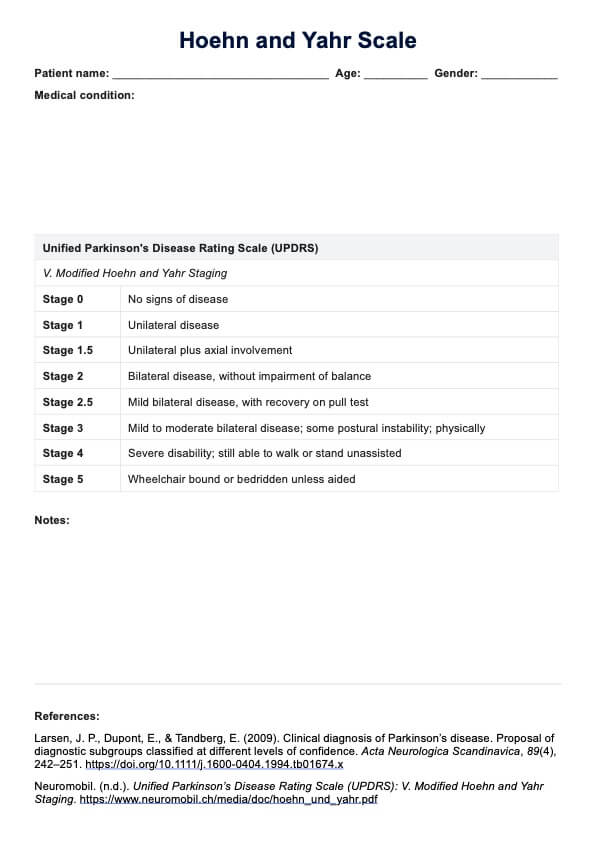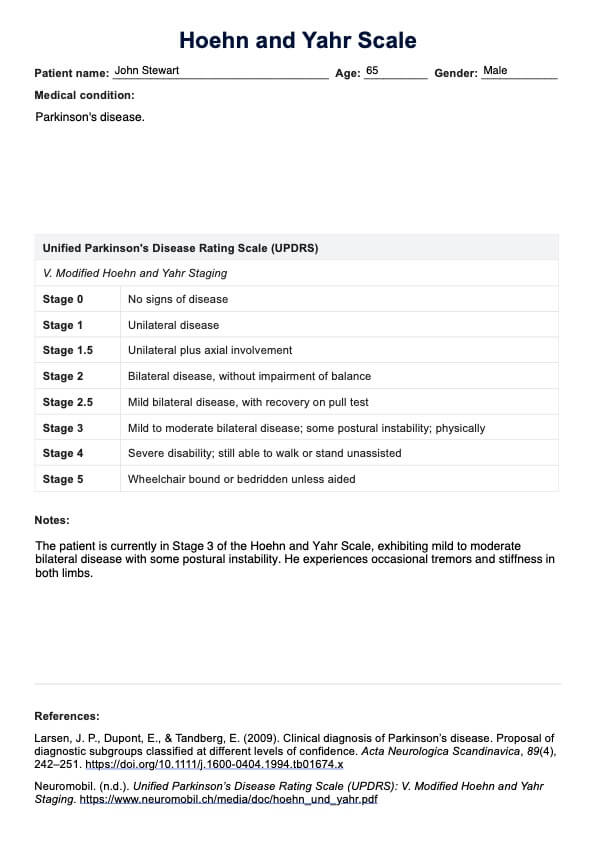Hoehn and Yahr Scale
Download Carepatron's free PDF guide on the Hoehn and Yahr Scale, including examples and explanations of its use in evaluating Parkinson's disease progression.


What is Parkinson's disease?
Parkinson's disease (PD) is a progressive neurological disorder that primarily causes movement disorders. It is characterized by the gradual loss of dopamine-producing neurons in the brain, particularly in the substantia nigra region. Dopamine is a neurotransmitter crucial for coordinating smooth and balanced muscle movement. As Parkinson's disease progresses, individuals may experience a variety of motor symptoms.
The Hoehn and Yahr Scale is a commonly used tool to assess the progression of Parkinson's disease, categorizing it into stages ranging from mild unilateral involvement to severe bilateral disease with significant functional disability. Early stages are often characterized by symptoms affecting one side of the body (unilateral involvement), while later stages typically exhibit symptoms on both sides (bilateral involvement).
Symptoms of Parkinson's disease
Parkinson's disease manifests primarily through motor symptoms that gradually worsen over time. These include tremors, often starting in one hand; rigidity or stiffness in limbs and trunk; bradykinesia, or slowed movements; and impaired balance and coordination, leading to postural instability. Non-motor symptoms may also arise, such as cognitive changes, depression, sleep disturbances, and autonomic dysfunction affecting blood pressure and bowel function.
Causes of Parkinson's disease
The exact cause of Parkinson disease remains unclear, but both genetic and environmental factors are believed to play significant roles. Genetic mutations, such as those in the LRRK2 and SNCA genes, can predispose individuals to the disease. Environmental factors like exposure to certain toxins or pesticides may also contribute to its development. Parkinson disease is characterized by the gradual degeneration of dopamine-producing neurons in the brain's substantia nigra region. This dopamine deficiency leads to the characteristic motor symptoms associated with the disease. Research continues to explore these factors to better understand and potentially intervene in the onset and progression of Parkinson's disease and other balance bilateral involvement problems.
Hoehn and Yahr Scale Template
Hoehn and Yahr Scale Example
What is the Hoehn and Yahr Scale?
The Hoehn and Yahr staging, also known as the Yahr staging scale, is one of the most widely used rating scales in clinical settings to assess the progression of bilateral or midline involvement. Originally developed by Melvin Hoehn and Melvin Yahr in 1967, it categorizes the severity of the stand unassisted severe disability into broad stages based on the extent of motor impairment and functional disability unilateral involvement. The scale ranges from Stage 1, characterized by mild unilateral disease and minimal functional disability, to Stage 5, indicating severe bilateral disease with significant disability, including postural instability and axial involvement.
The Modified Hoehn and Yahr Scale has since been adapted to include more detailed criteria, such as the inclusion of unilateral and bilateral involvement, as well as the exclusion of cases with severe disability that limits self-care capacity. It serves as an essential outcome measure in clinical trials and practice, aiding in treatment planning and assessing the effectiveness of therapeutic interventions. Healthcare professionals use the Hoehn and Yahr Scale to track disease progression objectively, guiding decisions on medication adjustments and other management strategies to optimize patient care.
How is it scored, and how are the results interpreted?
The Hoehn and Yahr Scale categorizes Parkinson's disease into five stages based on clinical disability levels. Stages 1 and 2 represent early-stage PD, stages 2 and 3 mid-stage, and stages 4 and 5 advanced-stage PD.
The scale ranges from 0 (no signs of disease) to stage 5 (aided wheelchair-bound or bedridden without assistance), with each stage reflecting increasing severity of symptoms and functional impaired postural reflexes.
The modified Hoehn and Yahr scale incorporates detailed criteria to ensure consistent scoring and interpretation across different clinical settings, guiding treatment decisions and monitoring disease progression effectively.
How to use our Hoehn and Yahr Scale template
Carepatron's Hoehn and Yahr Scale template contains the modified staging and provides a structured approach for healthcare professionals to assess and monitor the progression of Parkinson's disease (PD) effectively. Here’s how medical professionals can utilize this tool to enhance patient care:
Step 1: Access the template
Accessing the Hoehn and Yahr Scale template on Carepatron is straightforward. Go to the Resource Library and find the template from there. You can also just download it via the button on this page.
Step 2: Review the template
Review the template to familiarize yourself with its structure and functionality. The Carepatron template includes fields for documenting specific stages of PD according to the modified Hoehn and Yahr staging, distinguishing between mild, moderate disability, and severe bilateral disease.
Step 3: Educate the patient about the template
Educating patients about the modified Hoehn and Yahr Scale and its use within Carepatron is crucial for fostering understanding and collaboration. Explain how the scale measures disease progression and how their data will be recorded and interpreted over time.
Step 4: Use the template for monitoring and follow-up
Use the template to monitor patients' symptoms and track changes in their condition over successive visits. The template's inclusion and exclusion criteria ensure consistent assessment, helping to refine treatment plans and improve patient outcomes.
Benefits of using this scale
Utilizing the modified Hoehn and Yahr Scale within Carepatron offers several advantages for healthcare professionals managing Parkinson's disease. Here are three key benefits:
Objective assessment of PD progression
The Hoehn and Yahr Scale provides a standardized method to objectively assess and categorize the progression of PD. By documenting stages ranging from mild bilateral disease to moderate bilateral disease, clinicians can track changes in motor symptoms over time with consistency and accuracy.
Treatment planning and monitoring
Using the modified Hoehn and Yahr Scale facilitates tailored treatment planning and ongoing monitoring of PD patients. Healthcare providers can use the scale's broad categories to adjust medications, therapies, and interventions based on the severity of symptoms and functional impairment.
Enhanced communication and collaboration
The use of a standardized scale like Hoehn and Yahr fosters clearer communication among healthcare teams and with patients. It enables more effective collaboration in developing comprehensive care plans and educating patients and caregivers about the disease progression and management strategies. This enhances overall patient care and improves outcomes in PD management.
Commonly asked questions
The Hoehn and Yahr scale measures the progression of Parkinson's disease (PD) based on the severity of motor symptoms and functional disability.
The Hoehn and Yahr staging scale categorizes PD into five stages: Stage 1 (mild bilateral disease) to Stage 5 (severe bilateral involvement with significant disability).
The Hoehn and Yahr scale is a clinical tool developed by Margaret Hoehn, MD and Melvin Yahr, MD used to classify the progression of Parkinson's disease, distinguishing between early-stage and advanced-stage symptoms.
Yes, the Hoehn and Yahr scale is widely recognized and used in clinical practice for its reliability and convergent validity in assessing and monitoring the progression of Parkinson's disease over time and see if an individual is physically independent. It is recommended by the Movement Disorder Society Task Force on Parkinson's Disease Scales criteria.







































































































